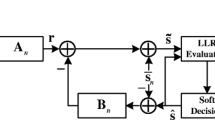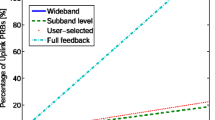Abstract
In this paper, we study the performance of a simple and easy‐to‐implement distributed power control strategy applicable to direct sequence code division multiple access (DS‐CDMA) networks. The scheme makes use of the received power measurements made on the forward link at individual mobile units to control the transmit powers on their reverse links. The algorithm, which effectively compensates for the slowly varying distance and shadow losses (due to their high correlation on both forward and reverse links), attempts to minimize the effect of fast multipath fading by averaging it out. We adopt a quasi‐analytic approach to estimate the reverse link capacity performance of an open‐loop power control scheme in both a single cell and a multi‐cell environment, and we do this for both a fixed base station and a moving base station scenario. Non‐stationary base stations are typical in tactical and emergency communications scenarios where the base stations could be mounted on moving platforms (e.g., tanks, jeeps, unmanned airborne vehicles). We estimate the capacity degradation, when base stations move relative to other cells, as a function of the amount of cell overlap and the standard deviation of the power control error. We also provide a comparison of the performance of the open‐loop power control strategy with that of a closed‐loop power control strategy.
Similar content being viewed by others
References
S. Ariyavisitakul and L.F. Chang, Signal and interference statistics of a CDMA system with feedback power control, IEEE Transactions on Communications 41(11) (November 1993) 1626‐1634.
T. Aulin, A modified model for the fading signal at a mobile radio channel, IEEE Transactions on Vehicular Technology 28 (August 1979) 182‐203.
A. Chockalingam, L.B. Milstein, P. Dietrich and R.R. Rao, Performance of closed-loop power control in DS-CDMA cellular systems, accepted in IEEE Transactions on Vehicular Technology.
R.H. Clarke, A statistical theory of mobile radio reception, Bell System Technical Journal 47 (July 1968) 957‐1000.
J. Conan, The weight spectra of some short low-rate convolutional codes, IEEE Transactions on Communications 32(9) (September 1984) 1050‐1053.
K.S. Gilhousen, I.M. Jacobs, R. Padovani, A.J. Viterbi and L.A. Weaver, On the capacity of a cellular CDMA system, IEEE Transactions on Vehicular Technology 40 (May 1991) 303‐312.
A.J. Goldsmith, L.J. Greenstein and G.J. Foschini, Error statistics of real-time power measurements in cellular channels with multipath and shadowing, IEEE Transactions on Vehicular Technology 43(3) (August 1994) 439‐446.
M. Gudmundson, Correlation model for shadow fading in mobile radio systems, Electronics Letters 27 (November 1991) 2145‐2146.
S.V. Hanley, An algorithm for combined cell-site selection and power control to maximize cellular spread spectrum capacity, IEEE Journal on Selected Areas in Communications 13(7) (September 1995) 1332‐1340.
M.C. Jeruchim, P. Balaban and K.S. Shanmugan, Simulation of Communication Systems (Plenum, New York, 1992).
L.B. Milstein, T.S. Rappaport and R. Barghouti, Performance evaluation for cellular CDMA, IEEE Journal on Selected Areas in Communications 10(4) (May 1992) 680‐689.
A.M. Monk, A. Chockalingam and L.B. Milstein, Open-loop power control error on a frequency selective CDMA channel, in: IEEE GLOBECOM' 94, Comm. Theory Mini-Conf. Rec. (December 1994) pp. 29‐33.
A.M. Monk and L.B. Milstein, A CDMA cellular system in a mobile base station environment, in: Conf. Rec., IEEE GLOBECOM' 93, 4 (November 1993) pp. 65‐69.
A.M. Monk and L.B. Milstein, Open-loop power control error in a land mobile satellite system, IEEE Journal on Selected Areas in Communications 13(2) (February 1995) 205‐212.
R.W. Nettleton and H. Alavi, Power control for a spread spectrum cellular mobile radio system, in: Conf. Rec., IEEE Veh. Tech. Conf. (1983) pp. 242‐246.
J.D. Parsons and A.M.D. Turkmani, Characterization of mobile radio signals: model description, IEE Proceedings-I, 138 (December 1991) 549‐556.
J.G. Proakis, Digital Communications (McGraw-Hill, New York, 1989).
G.L. Stuber and C. Kchao, Analysis of a multiple-cell direct-sequence CDMA cellular mobile radio system, IEEE Journal on Selected Areas in Communications 10(4) (May 1992) 669‐679.
B.R. Vojcic, R.L. Pickholtz and L.B. Milstein, Performance of DSCDMA with imperfect power control operating over a low earth orbiting satellite link, IEEE Journal on Selected Areas in Communications 12(4) (May 1994) 560‐567.
R.D. Yates and C.Y. Huang, Integrated power control and base station assignment, IEEE Transactions on Vehicular Technology 44(3) (August 1995) 638‐644.
Author information
Authors and Affiliations
Rights and permissions
About this article
Cite this article
Chockalingam, A., Milstein, L.B. Open‐loop power control performance in DS‐CDMA networks with frequency selective fading and non‐stationary base stations. Wireless Networks 4, 249–261 (1998). https://doi.org/10.1023/A:1019112324469
Issue Date:
DOI: https://doi.org/10.1023/A:1019112324469




